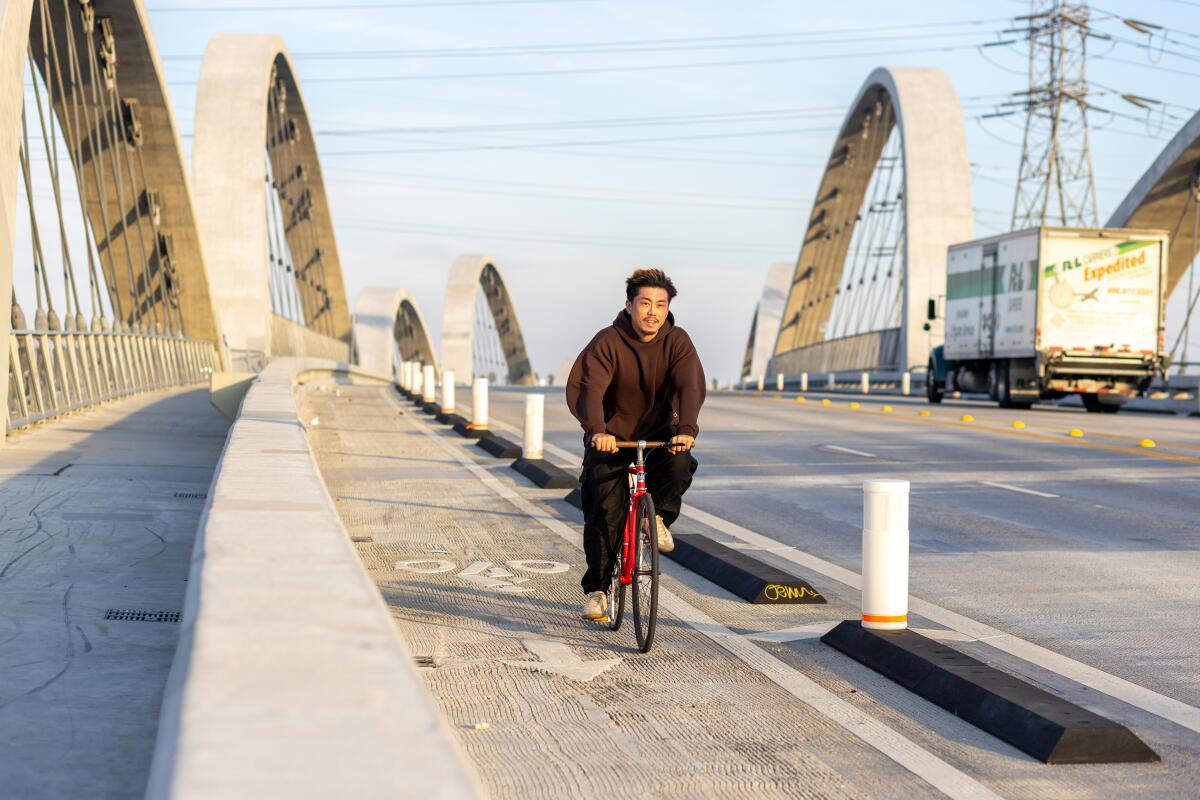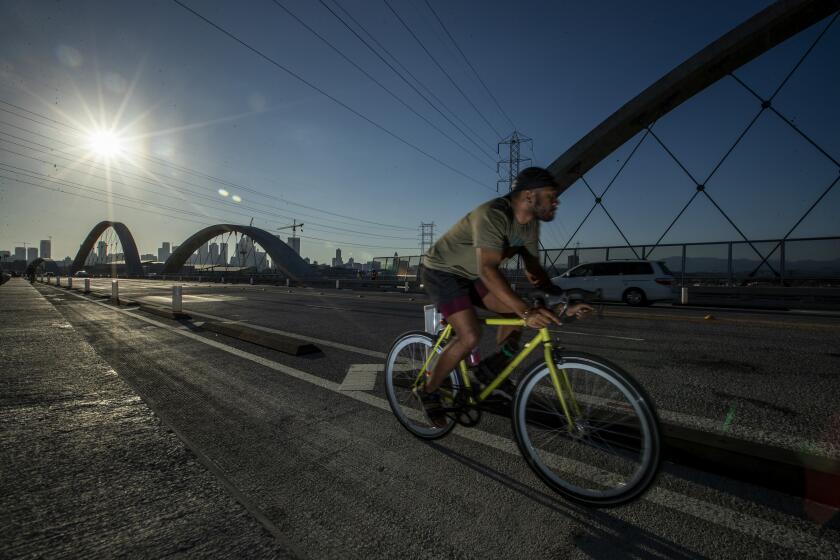Firefighters launch campaign against Measure HLA, saying ‘road diets’ threaten safety

The union that represents Los Angeles city firefighters launched a campaign this week against Measure HLA, delivering the first serious threat to a ballot proposal intended to improve safety on the city’s streets.
United Firefighters of Los Angeles City Local 112 plans to spend “six figures” — at least $100,000 — on a campaign against Measure HLA, which would require the installation of hundreds of miles of new bicycle lanes, bus lanes and other transportation improvements on designated boulevards that undergo major repairs.
Union President Freddy Escobar said his organization, which represents about 3,400 firefighters, is concerned that the measure will lead to slower emergency response times and put new pressure on a city budget already experiencing financial strain. Firetrucks are already being hindered by “road diets” — reductions in vehicle lanes caused by the creation of bike or bus lanes, Escobar said in an interview.
“Every second counts. The road diets slow down our firefighters,” Escobar said. “And it will be so much worse with HLA.”
Backers of Measure HLA denounced the move by the union, saying the ballot proposal is urgently needed to reduce the number of deaths on L.A. streets. Last year, 336 people died in traffic fatalities, more than half of them pedestrians, with those deaths now exceeding the number of homicides.
The citizen-sponsored ballot measure would mandate that L.A. implement its own street plan to add bike lanes and pedestrian- and transit-friendly improvements.
“If we are really talking about public safety for everyone ... then we have to address this as a public health crisis,” said Eli Lipmen, executive director of Move LA, a transit advocacy group that supports HLA.
HLA’s proponents contend that bike lanes and other improvements will lower traffic speeds, reducing the danger experienced by pedestrians and bicyclists. They also have sought to rebut the union’s claims, saying the city’s own environmental analysis found that access for emergency vehicles would remain the same or improve if new street improvements are completed.
The union’s announcement comes at a time of growing debate over Measure HLA, the only legislation to appear on the ballot in the March 5 city election. If passed, HLA would force city agencies to complete a list of transportation projects spelled out in Mobility Plan 2035, a planning document approved by the council nine years ago.
City Administrative Officer Matt Szabo, the city’s top budget analyst, warned several months ago that the measure could cost more than $2.5 billion over the next 10 years, or an average of $250 million per year. In a financial impact statement provided to voters, Szabo said that projects required under Measure HLA could reduce the number of streets that are repaved each year.
Streets for All, an advocacy group, originally conceived of HLA. Michael Schneider, who founded that organization and is running the pro-HLA campaign, pushed back against the city’s financial assessment, calling Szabo’s cost estimates dramatically inflated.
Schneider said the HLA campaign reached a much different cost estimate after obtaining records from the city’s Department of Transportation and Bureau of Engineering. After reviewing documents on sidewalk and bicycle lane projects, the HLA campaign concluded the ballot measure would cost about $28.6 million per year, if all the projects are completed within a decade.
“We don’t think the [city’s] estimate is an honest representation of the cost,” he said.
Szabo said Tuesday that he stands by his numbers, calling them “conservative estimates.”
While the firefighters union has put together a committee to fight HLA, Schneider’s campaign is receiving a boost from a different union: Unite Here Local 11, which represents hotel and restaurant workers, and has produced campaign materials in support of the measure.
Schneider said the HLA campaign also has secured endorsements from six council members so far: Marqueece Harris-Dawson, Eunisses Hernandez, Heather Hutt, Nithya Raman, Hugo Soto-Martínez and Katy Yaroslavsky.
Raman, in an interview, cast doubt on the arguments from the firefighter union. “The data shows over and over again that if you slow streets down, you have fewer deaths on the streets,” she said.
Measure HLA would mandate the installation of 200 miles of bus lanes — some operating 24 hours a day, others running only during rush hour — and more than 600 miles of bicycle lanes. If city crews conduct repairs over one-eighth of a mile on a particular street, then any Mobility Plan project envisioned for that stretch would need to be incorporated into the road work.
In the San Fernando Valley, HLA calls for bicycle lanes on Ventura Boulevard from Woodland Hills east to North Hollywood. The vast majority of Ventura also would receive bus lanes as part of the ballot proposal, Schneider said.
On the Eastside, the city would need to install protected bike lanes on Soto Street from Huntington Drive to Whittier Boulevard and on Whittier Boulevard across Boyle Heights, according to proponents of the measure. In Hollywood, unprotected bike lanes would be added to Santa Monica Boulevard, they said.
Bus lanes — either 24-hour or rush-hour only — would be installed on Broadway from downtown to Imperial Highway in South Los Angeles, the HLA campaign said.
Schneider accused city officials of assuming the city would carry out the “Rolls Royce” versions of each HLA project, when less expensive alternatives are available. He pointed to HLA’s plan for 238 miles of protected bike lanes, the kind that are separated from car traffic.
Get the lowdown on L.A. politics
Sign up for our L.A. City Hall newsletter to get weekly insights, scoops and analysis.
You may occasionally receive promotional content from the Los Angeles Times.
Although city agencies could achieve that goal by constructing expensive concrete medians to keep bicyclists away from traffic, they could also put in bollards, a much cheaper alternative, he said.
The HLA campaign’s arguments have not reassured everyone on the council.
Councilmember Traci Park, who opposes the measure, said she worries that the projects required under HLA would leave the city with fewer dollars for other public services, such as programs to address homelessness.
“I’m confident there is a way to build a system [of bike lanes] out that meets our mobility and sustainability goals,” she said. “But this budgeting by ballot measure is something that unfortunately removes all council office discretion. It eliminates community engagement. It opens up the floodgates for lawsuits.”
The firefighter union has also focused on other L.A. city races, putting more than $300,000 into efforts to elect council candidate Ethan Weaver, who is running to unseat Raman.
The union also has been spending money to support the reelection campaigns of Harris-Dawson, Hutt and Councilmembers John Lee and Imelda Padilla.
More to Read
Sign up for Essential California
The most important California stories and recommendations in your inbox every morning.
You may occasionally receive promotional content from the Los Angeles Times.













